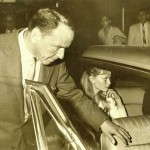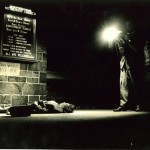Exhibit shows photographer Mel Finkelstein was no paparazzo
Lennie BennettLennie Bennett, Times Art Critic

Mel Finkelstein was part of a breed that no longer exists, the gumshoe photographer who roamed city streets night and day to chronicle life at its highest and lowest, with occasional stops for those in-between moments. He worked for several New York newspapers over his long career, probably most significantly at the Daily News, which was known for its emphasis on photographs. It was required looking for locals.
An exhibition of Finkelstein’s work at the Leepa-Rattner Museum of Art spans four decades, from the 1950s through the 1980s, and was organized with the help of Susan Balin, one of his four daughters and a successful photographer herself who lives in Tarpon Springs. The show is a chronicle of a career, a genre and a time now in the past. Museum director Lynn Whitelaw makes no pretensions to its value as fine art photography. Finkelstein, who died in 1992 at 60, would have scoffed in his brash New York way had anyone tried. It is darned fine visual reporting though he probably would have scoffed at that term, too, along with labels we use now, such as photojournalist or visual journalist.
And eager as he was to get shots of elusive celebrities, he positively scorned a new group that arose during his career, the paparazzi, whose methods of stalking and baiting he considered unfair play. That said, Frank Sinatra once ordered his driver to run Finkelstein over (he loved Sinatra and photographed him often) and actually clipped Finkelstein with a fender.
In many ways Finkelstein was an inheritor of Arthur Fellig, far more famous and known to the world as Weegee, who became the definitive street photographer in New York a generation earlier. Finkelstein had the same uncanny nose for news, sniffing out an important story among the hundreds of routine occurrences that came over the police radios or were phoned in as tips. And he was lucky. Covering a fire at the Plaza Hotel in the 1960s, he was following rescuers up to the 15th floor and mistakenly wound up on the 14th floor in time to see a startled blond walking down the corridor dressed in a mink coat and not much else. That photograph of Kim Novak made the front page of the Daily News.
But he and his peers really surpassed Weegee as image hounds, thanks in part to the development of the 35mm camera. This was a much more rapid-fire instrument than the boxy Speed Graphic in common use for decades.
More than that, though, one gets the sense that Finkelstein cared as much about the story behind his photos as their dramatic potential. At a crime scene, he could find the telling detail that would make the pathos of an incident as important as its gory commercial appeal, as in the photo of a dead woman outside a church under the sign reading “All Welcome.” He started out covering race riots in Harlem but became committed to civil rights reporting, even when he was unwelcome because he was white. (Three of his ribs were broken during one clash between police and protesters when a brick smashed through his car window.)
There were 63 staff photographers at the Daily News and all were competing for space on its pages. Until he moved to the New York Post as its photography editor in 1988, he hustled every day and few went by that did not include several Finkelstein photos that told New Yorkers what had transpired 24 hours earlier.
So we see Marilyn Monroe and Arthur Miller leaving a party juxtaposed with Chinese delegates being seated for the first time at the United Nations (for which he got a Pulitzer nomination), and a photograph of Jacqueline Kennedy Onassis in a limousine near another one of a homeless woman carrying an I Love NY bag.
One photo not in the exhibition had him in front of the camera rather than behind it. In the fall of 1969, he and several other photographers were hanging around a Manhattan movie theater where Ari and Jacqueline Onassis were watching the Swedish cult film I Am Curious (Yellow). She left the theater first and as the photographers began shooting her, she allegedly walked over to Finkelstein and flipped him to the pavement. (He was of average size and weight but said he was caught completely off guard.) A photograph of him lying on the sidewalk as she walks away, taken by another journalist, made national headlines. She claimed through a spokesperson he must have slipped. He didn’t pursue the matter.
For him it was just another day at the office, no more or less important than a young girl in Harlem jumping over the net strung across a city street for a makeshift tennis court. Or lovers meeting in a park. The Beatles performing. He knew his territory well. This exhibition makes us feel as if we do, too.
Mel Finkelstein: Playing a Hunch Opens at Leepa-Rattner Museum of Art
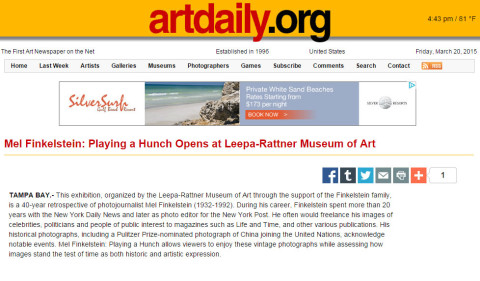
TAMPA BAY.- This exhibition, organized by the Leepa-Rattner Museum of Art through the support of the Finkelstein family, is a 40-year retrospective of photojournalist Mel Finkelstein (1932-1992). During his career, Finkelstein spent more than 20 years with the New York Daily News and later as photo editor for the New York Post. He often would freelance his images of celebrities, politicians and people of public interest to magazines such as Life and Time, and other various publications. His historical photographs, including a Pulitzer Prize-nominated photograph of China joining the United Nations, acknowledge notable events. Mel Finkelstein: Playing a Hunch allows viewers to enjoy these vintage photographs while assessing how images stand the test of time as both historic and artistic expression.
Work Of Former News Photographer On Display
Cheryl Bentley The Suncoast News
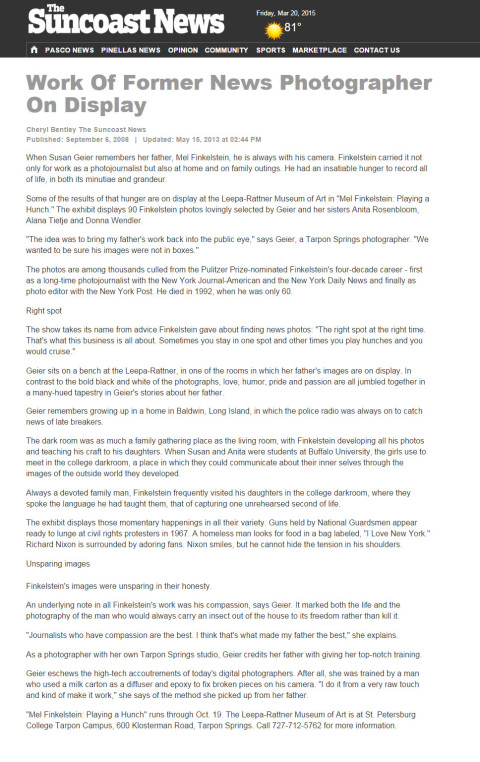
When Susan Balin remembers her father, Mel Finkelstein, he is always with his camera. Finkelstein carried it not only for work as a photojournalist but also at home and on family outings. He had an insatiable hunger to record all of life, in both its minutiae and grandeur.
Some of the results of that hunger are on display at the Leepa-Rattner Museum of Art in “Mel Finkelstein: Playing a Hunch.” The exhibit displays 90 Finkelstein photos lovingly selected by Geier and her sisters Anita Rosenbloom, Alana Tietje and Donna Wendler.
“The idea was to bring my father’s work back into the public eye,” says Geier, a Tarpon Springs photographer. “We wanted to be sure his images were not in boxes.”
The photos are among thousands culled from the Pulitzer Prize-nominated Finkelstein’s four-decade career – first as a long-time photojournalist with the New York Journal-American and the New York Daily News and finally as photo editor with the New York Post. He died in 1992, when he was only 60.
Right spot
The show takes its name from advice Finkelstein gave about finding news photos: “The right spot at the right time. That’s what this business is all about. Sometimes you stay in one spot and other times you play hunches and you would cruise.”
Geier sits on a bench at the Leepa-Rattner, in one of the rooms in which her father’s images are on display. In contrast to the bold black and white of the photographs, love, humor, pride and passion are all jumbled together in a many-hued tapestry in Geier’s stories about her father.
Geier remembers growing up in a home in Baldwin, Long Island, in which the police radio was always on to catch news of late breakers.
The dark room was as much a family gathering place as the living room, with Finkelstein developing all his photos and teaching his craft to his daughters. When Susan and Anita were students at Buffalo University, the girls use to meet in the college darkroom, a place in which they could communicate about their inner selves through the images of the outside world they developed.
Always a devoted family man, Finkelstein frequently visited his daughters in the college darkroom, where they spoke the language he had taught them, that of capturing one unrehearsed second of life.
The exhibit displays those momentary happenings in all their variety. Guns held by National Guardsmen appear ready to lunge at civil rights protesters in 1967. A homeless man looks for food in a bag labeled, “I Love New York.” Richard Nixon is surrounded by adoring fans. Nixon smiles, but he cannot hide the tension in his shoulders.
Unsparing images
Finkelstein’s images were unsparing in their honesty.
An underlying note in all Finkelstein’s work was his compassion, says Geier. It marked both the life and the photography of the man who would always carry an insect out of the house to its freedom rather than kill it.
“Journalists who have compassion are the best. I think that’s what made my father the best,” she explains.
As a photographer with her own Tarpon Springs studio, Geier credits her father with giving her top-notch training.
Geier eschews the high-tech accoutrements of today’s digital photographers. After all, she was trained by a man who used a milk carton as a diffuser and epoxy to fix broken pieces on his camera. “I do it from a very raw touch and kind of make it work,” she says of the method she picked up from her father.
“Mel Finkelstein: Playing a Hunch” runs through Oct. 19. The Leepa-Rattner Museum of Art is at St. Petersburg College Tarpon Campus, 600 Klosterman Road, Tarpon Springs. Call 727-712-5762 for more information.
Museum exhibit puts focus on NY photojournalist’s career
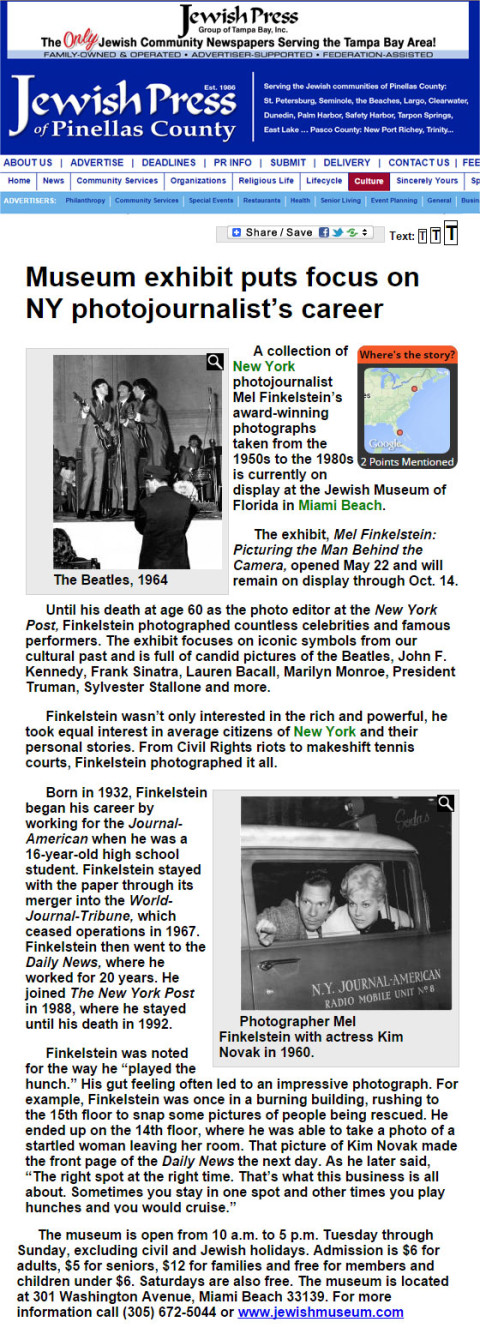 A collection of New York photojournalist Mel Finkelstein’s award-winning photographs taken from the 1950s to the 1980s is currently on display at the Jewish Museum of Florida in Miami Beach.
A collection of New York photojournalist Mel Finkelstein’s award-winning photographs taken from the 1950s to the 1980s is currently on display at the Jewish Museum of Florida in Miami Beach.
The exhibit, Mel Finkelstein: Picturing the Man Behind the Camera, opened May 22 and will remain on display through Oct. 14.
Until his death at age 60 as the photo editor at the New York Post, Finkelstein photographed countless celebrities and famous performers. The exhibit focuses on iconic symbols from our cultural past and is full of candid pictures of the Beatles, John F. Kennedy, Frank Sinatra, Lauren Bacall, Marilyn Monroe, President Truman, Sylvester Stallone and more.
Finkelstein wasn’t only interested in the rich and powerful, he took equal interest in average citizens of New York and their personal stories. From Civil Rights riots to makeshift tennis courts, Finkelstein photographed it all.
Born in 1932, Finkelstein began his career by working for the Journal-American when he was a 16-year-old high school student. Finkelstein stayed with the paper through its merger into the World-Journal-Tribune, which ceased operations in 1967. Finkelstein then went to the Daily News, where he worked for 20 years. He joined The New York Post in 1988, where he stayed until his death in 1992.
Finkelstein was noted for the way he “played the hunch.” His gut feeling often led to an impressive photograph. For example, Finkelstein was once in a burning building, rushing to the 15th floor to snap some pictures of people being rescued. He ended up on the 14th floor, where he was able to take a photo of a startled woman leaving her room. That picture of Kim Novak made the front page of the Daily News the next day. As he later said, “The right spot at the right time. That’s what this business is all about. Sometimes you stay in one spot and other times you play hunches and you would cruise.”
The museum is open from 10 a.m. to 5 p.m. Tuesday through Sunday, excluding civil and Jewish holidays. Admission is $6 for adults, $5 for seniors, $12 for families and free for members and children under $6. Saturdays are also free. The museum is located at 301 Washington Avenue, Miami Beach 33139.
Museum features art, photographs
May 30, 2012|By Sergio Carmona, Staff Writer
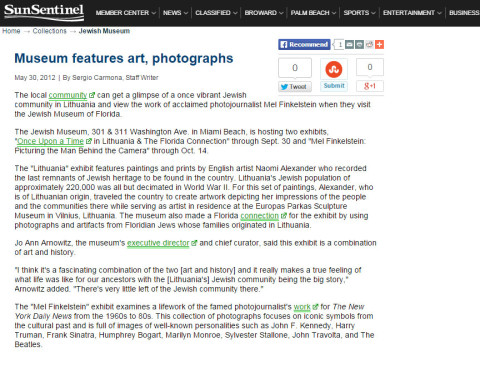
The local community can get a glimpse of a once vibrant Jewish community in Lithuania and view the work of acclaimed photojournalist Mel Finkelstein when they visit the Jewish Museum of Florida.
The Jewish Museum, 301 & 311 Washington Ave. in Miami Beach, is hosting two exhibits, “Once Upon a Time in Lithuania & The Florida Connection” through Sept. 30 and “Mel Finkelstein: Picturing the Man Behind the Camera” through Oct. 14.
The “Lithuania” exhibit features paintings and prints by English artist Naomi Alexander who recorded the last remnants of Jewish heritage to be found in the country. Lithuania’s Jewish population of approximately 220,000 was all but decimated in World War II. For this set of paintings, Alexander, who is of Lithuanian origin, traveled the country to create artwork depicting her impressions of the people and the communities there while serving as artist in residence at the Europas Parkas Sculpture Museum in Vilnius, Lithuania. The museum also made a Florida connection for the exhibit by using photographs and artifacts from Floridian Jews whose families originated in Lithuania.
Jo Ann Arnowitz, the museum’s executive director and chief curator, said this exhibit is a combination of art and history.
“I think it’s a fascinating combination of the two [art and history] and it really makes a true feeling of what life was like for our ancestors with the [Lithuania’s] Jewish community being the big story,” Arnowitz added. “There’s very little left of the Jewish community there.”
The “Mel Finkelstein” exhibit examines a lifework of the famed photojournalist’s work for The New York Daily News from the 1960s to 80s. This collection of photographs focuses on iconic symbols from the cultural past and is full of images of well-known personalities such as John F. Kennedy, Harry Truman, Frank Sinatra, Humphrey Bogart, Marilyn Monroe, Sylvester Stallone, John Travolta, and The Beatles.
Seize the Subject
A photographer grabs first, shoots later.
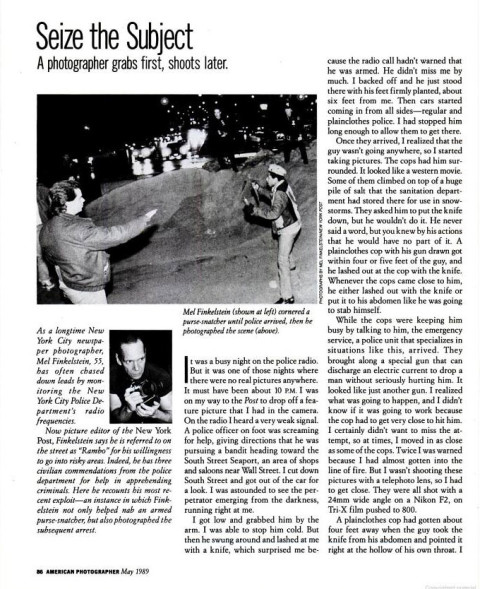
World Press Photo
1971, Mel Finkelstein, 1st prize, News
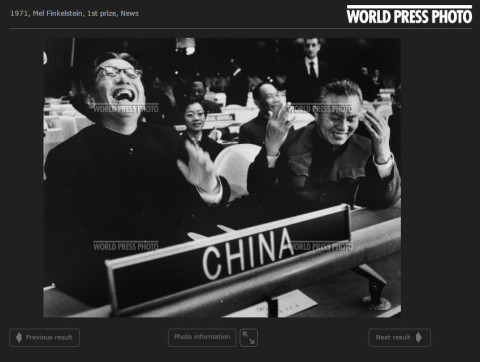
Three-generation photo show
Special to Compass
Published Friday, August 17, 2007
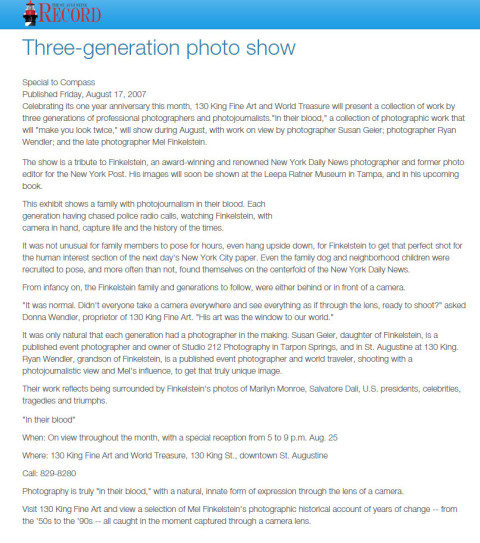
Celebrating its one year anniversary this month, 130 King Fine Art and World Treasure will present a collection of work by three generations of professional photographers and photojournalists.”In their blood,” a collection of photographic work that will “make you look twice,” will show during August, with work on view by photographer Susan Balin; photographer Ryan Wendler; and the late photographer Mel Finkelstein.
The show is a tribute to Finkelstein, an award-winning and renowned New York Daily News photographer and former photo editor for the New York Post. His images will soon be shown at the Leepa Ratner Museum in Tampa, and in his upcoming book.
This exhibit shows a family with photojournalism in their blood. Each generation having chased police radio calls, watching Finkelstein, with camera in hand, capture life and the history of the times.
It was not unusual for family members to pose for hours, even hang upside down, for Finkelstein to get that perfect shot for the human interest section of the next day’s New York City paper. Even the family dog and neighborhood children were recruited to pose, and more often than not, found themselves on the centerfold of the New York Daily News.
From infancy on, the Finkelstein family and generations to follow, were either behind or in front of a camera.
“It was normal. Didn’t everyone take a camera everywhere and see everything as if through the lens, ready to shoot?” asked Donna Wendler, proprietor of 130 King Fine Art. “His art was the window to our world.”
It was only natural that each generation had a photographer in the making. Susan Balin, daughter of Finkelstein, is a published event photographer and owner of Studio 212 Photography in Tarpon Springs, and in St. Augustine at 130 King. Ryan Wendler, grandson of Finkelstein, is a published event photographer and world traveler, shooting with a photojournalistic view and Mel’s influence, to get that truly unique image.
Their work reflects being surrounded by Finkelstein’s photos of Marilyn Monroe, Salvatore Dali, U.S. presidents, celebrities, tragedies and triumphs.
“In their blood”
When: On view throughout the month, with a special reception from 5 to 9 p.m. Aug. 25
Where: 130 King Fine Art and World Treasure, 130 King St., downtown St. Augustine
Call: 829-8280
Photography is truly “in their blood,” with a natural, innate form of expression through the lens of a camera.
Visit 130 King Fine Art and view a selection of Mel Finkelstein’s photographic historical account of years of change — from the ’50s to the ’90s — all caught in the moment captured through a camera lens.
Stranded Passengers at Idelwild Airport
Some of the 101 passengers left stranded at Idelwild Airport by a canceled charter flight to Europe.
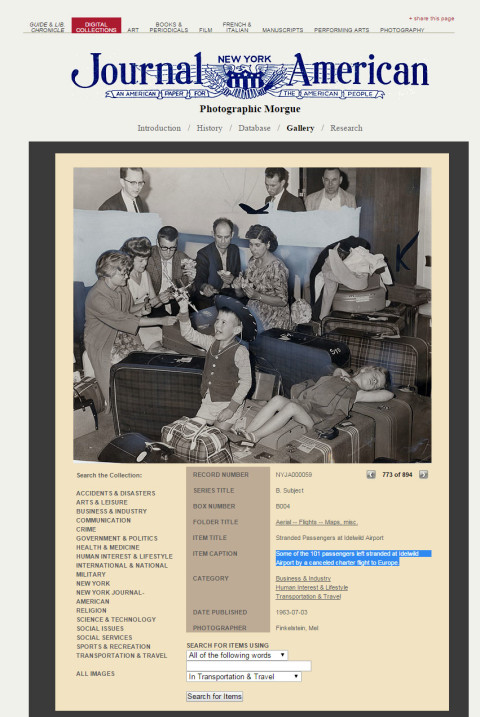
Mel Finkelstein, 60; Took Photographs for Several Papers
By BRUCE LAMBERT
Published: October 25, 1992
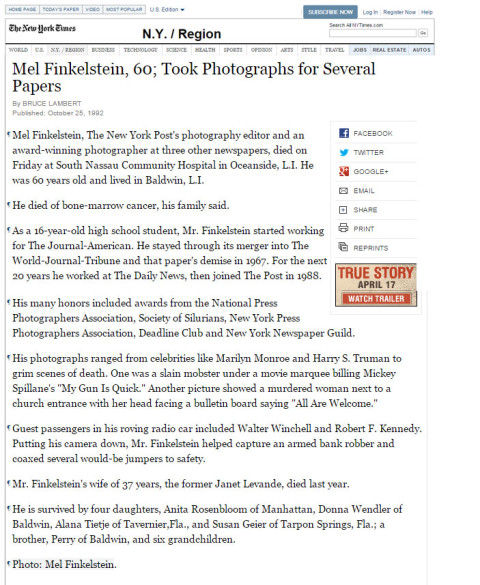
Mel Finkelstein, The New York Post’s photography editor and an award-winning photographer at three other newspapers, died on Friday at South Nassau Community Hospital in Oceanside, L.I. He was 60 years old and lived in Baldwin, L.I.
He died of bone-marrow cancer, his family said.
As a 16-year-old high school student, Mr. Finkelstein started working for The Journal-American. He stayed through its merger into The World-Journal-Tribune and that paper’s demise in 1967. For the next 20 years he worked at The Daily News, then joined The Post in 1988.
His many honors included awards from the National Press Photographers Association, Society of Silurians, New York Press Photographers Association, Deadline Club and New York Newspaper Guild.
His photographs ranged from celebrities like Marilyn Monroe and Harry S. Truman to grim scenes of death. One was a slain mobster under a movie marquee billing Mickey Spillane’s “My Gun Is Quick.” Another picture showed a murdered woman next to a church entrance with her head facing a bulletin board saying “All Are Welcome.”
Guest passengers in his roving radio car included Walter Winchell and Robert F. Kennedy. Putting his camera down, Mr. Finkelstein helped capture an armed bank robber and coaxed several would-be jumpers to safety.
Mr. Finkelstein’s wife of 37 years, the former Janet Levande, died last year.
He is survived by four daughters, Anita Rosenbloom of Manhattan, Donna Wendler of Baldwin, Alana Tietje of Tavernier,Fla., and Susan Balin of Tarpon Springs, Fla.; a brother, Perry of Baldwin, and six grandchildren.
Photo: Mel Finkelstein.

